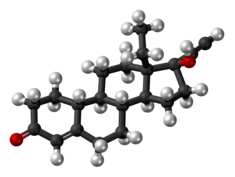Our website is made possible by displaying online advertisements to our visitors.
Please consider supporting us by disabling your ad blocker.
Levonorgestrel
 | |
 | |
| Clinical data | |
|---|---|
| Trade names | Plan B, Julie, Mirena, Plan B One-Step, Liletta, others |
| Other names | LNG; LNG-EC; d-Norgestrel; d(–)-Norgestrel; D-Norgestrel; WY-5104; SH-90999; NSC-744007; 18-Methylnorethisterone; 17α-Ethynyl-18-methyl-19-nortestosterone; 17α-Ethynyl-18-methylestr-4-en-17β-ol-3-one; 13β-Ethyl-17α-hydroxy-18,19-dinorpregn-4-en-20-yn-3-one |
| AHFS/Drugs.com | Monograph |
| MedlinePlus | a610021 |
| Pregnancy category | |
| Routes of administration | By mouth, transdermal patch, intrauterine device, subcutaneous implant |
| Drug class | Progestogen (medication); Progestin |
| ATC code | |
| Legal status | |
| Legal status | |
| Pharmacokinetic data | |
| Bioavailability | 95% (range 85–100%)[4][5] |
| Protein binding | 98% (50% to albumin, 48% to SHBG)[4] |
| Metabolism | Liver (reduction, hydroxylation, conjugation)[4][6] |
| Metabolites | • 5α-Dihydro-LNG[4] |
| Elimination half-life | 24–32 hours[4] |
| Excretion | Urine: 20–67% Feces: 21–34%[6] |
| Identifiers | |
| |
| CAS Number | |
| PubChem CID | |
| IUPHAR/BPS | |
| DrugBank | |
| ChemSpider | |
| UNII | |
| KEGG | |
| ChEBI | |
| ChEMBL | |
| CompTox Dashboard (EPA) | |
| ECHA InfoCard | 100.011.227 |
| Chemical and physical data | |
| Formula | C21H28O2 |
| Molar mass | 312.453 g·mol−1 |
| 3D model (JSmol) | |
| Melting point | 235 to 237 °C (455 to 459 °F) |
| |
| |
| (verify) | |
Levonorgestrel is a hormonal medication which is used in a number of birth control methods.[3][7] It is combined with an estrogen to make combination birth control pills.[8] As an emergency birth control, sold under the brand names Plan B One-Step and Julie, among others, it is useful within 72 hours of unprotected sex.[3][7][9] The more time that has passed since sex, the less effective the medication becomes, and it does not work after pregnancy (implantation) has occurred.[7] Levonorgestrel works by preventing ovulation or fertilization from occurring.[10] It decreases the chances of pregnancy by 57–93%.[11] In an intrauterine device (IUD), such as Mirena among others, it is effective for the long-term prevention of pregnancy.[7] A levonorgestrel-releasing implant is also available in some countries.[12]
Common side effects include nausea, breast tenderness, headaches, and increased, decreased, or irregular menstrual bleeding.[7] When used as an emergency contraceptive, if pregnancy occurs, there is no evidence that its use harms the fetus.[7] It is safe to use during breastfeeding.[7] Birth control that contains levonorgestrel will not change the risk of sexually transmitted infections.[7] It is a progestin and has effects similar to those of the hormone progesterone.[7] It works primarily by preventing ovulation and closing off the cervix to prevent the passage of sperm.[7]
Levonorgestrel was patented in 1960 and introduced for medical use together with ethinylestradiol in 1970.[13][14] It is on the World Health Organization's List of Essential Medicines.[15] It is available as a generic medication.[16] In the United States, levonorgestrel-containing emergency contraceptives are available over the counter (OTC) for all ages.[17] In 2020, it was the 323rd most commonly prescribed medication in the United States, with more than 800 thousand prescriptions.[18]
- ^ a b "Levonorgestrel Use During Pregnancy". Drugs.com. 23 March 2020. Archived from the original on 2 July 2020. Retrieved 29 June 2020.
- ^ "Jaydess 13.5 mg intrauterine delivery system - Summary of Product Characteristics (SmPC)". (emc). 1 July 2022. Archived from the original on 13 April 2021. Retrieved 1 July 2022.
- ^ a b c "Plan B One-Step- levonorgestrel tablet". DailyMed. 21 December 2022. Retrieved 26 December 2022.
- ^ a b c d e Cite error: The named reference
pmid16112947was invoked but never defined (see the help page). - ^ Cite error: The named reference
pmid8842581was invoked but never defined (see the help page). - ^ a b Cite error: The named reference
ShoupeHaseltine2012was invoked but never defined (see the help page). - ^ a b c d e f g h i j "Progestins (Etonogestrel, Levonorgestrel, Norethindrone)". The American Society of Health-System Pharmacists. Archived from the original on 2015-09-07. Retrieved Aug 21, 2015.
- ^ Postgraduate Gynecology. Jaypee Brothers Medical Pub. 2011. p. 159. ISBN 9789350250822. Archived from the original on 2015-09-26.
- ^ "Levonorgestrel 1.5 mg Tablet Emergency Contraceptive: New Drug Application 21998, Supplement 5" (PDF). U.S. Food and Drug Administration.
- ^ "Now Is the Time to Change Label on Emergency Contraceptives". Relias Media | Online Continuing Medical Education | Relias Media - Continuing Medical Education Publishing. Retrieved 2022-08-16.
- ^ Gemzell-Danielsson K (November 2010). "Mechanism of action of emergency contraception". Contraception. 82 (5): 404–409. doi:10.1016/j.contraception.2010.05.004. PMID 20933113.
- ^ "Chapter 1". Research on reproductive health at WHO: biennial report 2000-2001. Geneva: World health organization. 2002. ISBN 9789241562089. Archived from the original on 2015-09-26.
- ^ Fischer J, Ganellin CR (2006). Analogue-based Drug Discovery. John Wiley & Sons. p. 479. ISBN 9783527607495. Archived from the original on 2021-08-28. Retrieved 2020-08-05.
- ^ Cite error: The named reference
Roth2014was invoked but never defined (see the help page). - ^ World Health Organization (2019). World Health Organization model list of essential medicines: 21st list 2019. Geneva: World Health Organization. hdl:10665/325771. WHO/MVP/EMP/IAU/2019.06. License: CC BY-NC-SA 3.0 IGO.
- ^ Hamilton RJ (2014). Tarascon pocket pharmacopoeia : 2014 deluxe lab-pocket edition (15th ed.). Sudbury: Jones & Bartlett Learning. pp. 310–312. ISBN 9781284053999. Archived from the original on 2015-09-26.
- ^ "FDA approves Plan B One-Step emergency contraceptive for use without a prescription for all women of child-bearing potential" (Press release). June 20, 2013. Archived from the original on 14 January 2016. Retrieved 2 February 2016.
- ^ "Levonorgestrel - Drug Usage Statistics". ClinCalc. Retrieved 7 October 2022.
Previous Page Next Page


